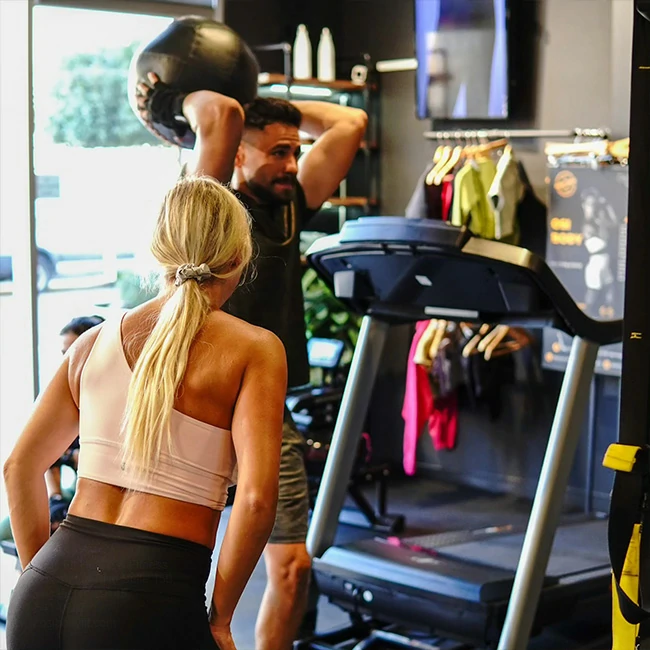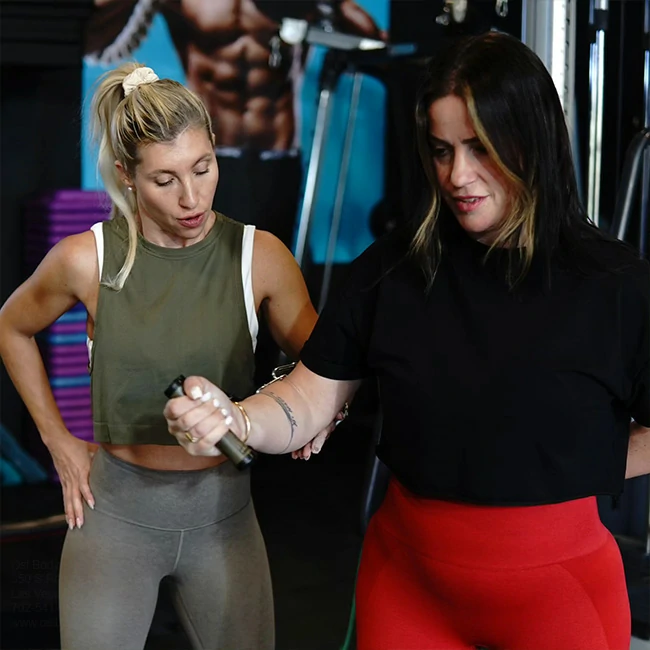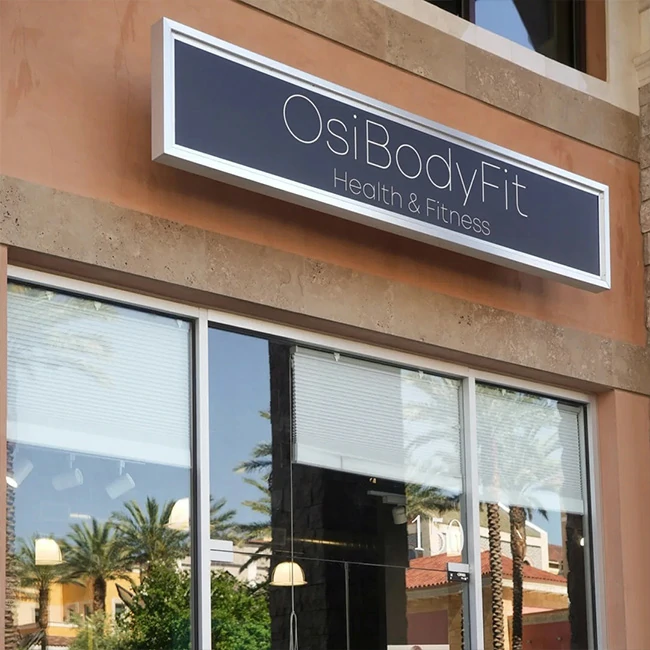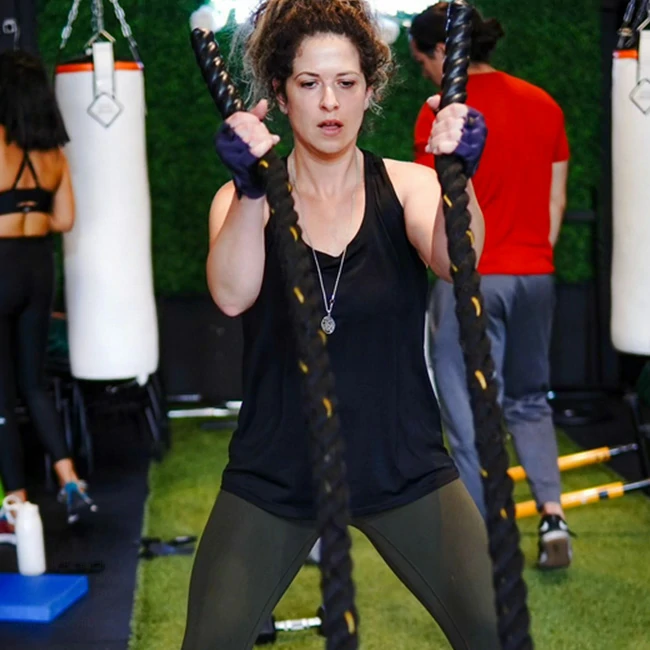Personal trainers are permitted to engage in physical contact with clients within the scope of professional training boundaries, strictly for instructional or safety purposes, such as form correction or exercise spotting. All physical interactions have to remain consensual, respect personal boundaries, and adhere to a professional standard to prevent any breach of ethical guidelines.
Professional Boundaries, A Mutual Understanding
In personal training, there’s a common perception that more physical coaching signals a deeper engagement from the trainer. However, an adept trainer knows that their effectiveness isn’t solely dependent on touch. Clients should always feel confident to express concerns if the touch feels more excessive than instructive. Swiftly addressing any discomfort is key to maintaining professional training boundaries and ensuring there’s no encroachment into inappropriate areas.
A Spectrum of Approaches To Touch Techniques
A personal trainer may employ a variety of touch techniques, ranging from a light tap to signal the start or end of a movement, to more supportive holds during complex exercises. Touch techniques in personal training vary based on the exercise, the client’s comfort level, and the trainer’s professional judgment. Here are some examples:
- Guided Touch: This is often a light, guiding touch used to direct a client into the correct posture or position. For instance, a trainer might gently touch your shoulder to encourage you to retract and lower it during a shoulder press.
- Corrective Touch: When a client is performing an exercise incorrectly and verbal cues are not sufficient, a trainer might use a firmer touch to physically correct the posture. This is common in exercises where incorrect form can lead to injury, such as squats or deadlifts.
- Spotting: In exercises like bench pressing or heavy squatting, a trainer employs supportive holds to maintain safety. This requires close physical proximity and touch, serving a primary role in averting accidents and injuries.
- Demonstrative Touch: Sometimes, a trainer will use their own body to demonstrate a movement or posture. This might involve placing a client’s hand on their (the trainer’s) back to demonstrate proper muscle engagement.
- Encouraging Touch: A brief pat on the back or shoulder can be used as a form of encouragement or to congratulate a client on a job well done.
While these touch techniques are part of professional training, consent and comfort need to be addressed. Clients should always feel empowered to express their personal training boundaries. A professional trainer will always respect these boundaries and adjust their methods accordingly. If a client ever feels uncomfortable with the level of physical contact, they should communicate this to their trainer immediately.
The Role Of Touch In Correcting Form
Mastery in applying touch to correct exercise forms is a significant aspect of personal training. It involves a sensitive equilibrium between offering physical guidance and honoring the client’s space and comfort.
Touch, when used appropriately, can be a powerful tool to safely correct exercise form. For example, during a squat, gentle guidance at the hips or lower back can significantly improve posture and reduce injury risk. However, this should be complemented with clear verbal cues, explaining the intent and benefit of the touch. It’s essential to clearly communicate what the touch is intended to achieve. For example, before making any physical contact, I might say, “I’m going to lightly touch your shoulder to help guide it back and down.” This not only prepares the client for the contact but also helps them understand the purpose behind it.
The choice to use physical contact should never be the default method for correction. Starting with verbal instructions and demonstrations is often effective. Touch is introduced only as a secondary measure, particularly when verbal cues aren’t sufficient or there’s a potential for injury. Even then, the touch should be minimal, respectful, and always within the comfort zone of the client.
Using touch for form correction is a dynamic aspect of personal training that demands a deep understanding of professional boundaries and effective communication. When applied with consideration and respect, it can significantly enhance the training experience, ensuring safety and effectiveness in every session.
Fortifying Trust and Comfort, The Bedrock of Fitness Progression
To ensure this alliance remains fortified, make sure to establish an open dialogue, setting the stage for a comfortable, productive, and, above all, safe workout environment. A personal trainer is present not just to sculpt your physique but to bolster your confidence in your capabilities and autonomy within the gym’s walls.
My mission extends beyond physical training. It’s also about fostering a trusting and empowering relationship. This starts with an initial consultation to understand your goals and preferences, including any concerns about touch and training methods. Regular check-ins are crucial to monitor not only your physical progress but also your comfort and confidence levels.
Educating you about each exercise is a priority, ensuring you understand their purpose and correct form. This empowers you and demystifies the gym environment. Open communication is key—I encourage you to share any concerns or questions at any time, and I’m committed to respecting your personal boundaries as a client and adjusting our sessions accordingly.
Celebrating your achievements, big or small, is a vital part of our journey. It’s not just about physical transformation; it’s about building a positive and respectful trainer-client relationship that enhances your overall well-being and fitness experience.
Navigating Physical Contact in Group Training Settings
When it comes to physical contact in training sessions, the approach varies significantly between group and individual settings.
To illustrate these differences more clearly, here’s a table highlighting the key contrasts:
| Aspect | Group Training Settings | Individual Sessions |
|---|---|---|
| Nature of Touch | Generalized, minimal, often limited to demonstrations | More personalized, specific to individual’s form and needs |
| Frequency of Touch | Less frequent, primarily used for general guidance | More frequent, tailored to individual requirements |
| Type of Adjustments | Broad, applicable to group norms | Specific, detailed corrections and adjustments |
| Comfort Level Management | Focus on maintaining a universally comfortable environment for all participants | Tailored to individual comfort and boundaries |
| Communication Style | More reliant on verbal cues and group demonstrations | Balanced between verbal cues and one-on-one physical guidance |
| Personalization | Limited due to the need to address the group as a whole | High, with adjustments based on individual feedback and progress |
The approach to physical contact in group training requires a universal consideration of comfort levels, emphasizing verbal communication and broad guidance. This ensures a comfortable and inclusive environment for all participants. In contrast, individual sessions offer a more tailored experience, with physical adjustments closely aligned with the client’s specific needs and preferences. Both scenarios demand professional and respectful handling of physical contact to ensure an effective and safe training experience.
Setting Boundaries Is A Two-Way Street
Setting boundaries in a personal training environment is a fundamental aspect of the trainer-client relationship. It’s a two-way street where both parties play crucial roles. My approach is grounded in mutual respect and open communication, ensuring that the boundaries set by clients are always acknowledged and upheld.
It’s important for clients to feel empowered to establish their own personal training boundaries. This can involve preferences regarding physical contact, the type of exercises they are comfortable with, or even the tone and manner of communication. I always encourage clients to voice their boundaries clearly at the outset, and at any point during our sessions, should their comfort levels change.
From my perspective as a trainer, respecting and maintaining these boundaries is non-negotiable. Whether it’s adjusting my approach to physical guidance or modifying training plans to align with a client’s comfort level, my actions are always guided by the boundaries set by the client. This respect for boundaries is not just about adhering to professional ethics; it’s about creating a training environment where clients feel safe, respected, and in control of their fitness journey.
Additionally, it’s a routine part of my sessions to revisit these boundaries. Preferences and comfort levels may shift over time, making it necessary to align training practices with these adjustments.
The process of setting and respecting boundaries is a dynamic and ongoing conversation. It’s about creating a partnership where both the trainer and the client are actively engaged in shaping a training experience that is effective, respectful, and aligned with the client’s individual needs and comfort levels.
Cultural Sensitivities and Personal Training
Being receptive to and accommodating the diverse cultural attitudes towards physical touch is fundamental for personal trainers. Cultivating a training space that is respectful and considerate of everyone’s cultural background is paramount.
Understanding cultural sensitivities related to touch is critical. People’s comfort with physical contact can vary greatly depending on their cultural upbringing. During initial meetings, I always discuss any cultural preferences or personal comfort levels regarding touch, which guides my approach to training.
Creating an inclusive environment means more than just understanding these differences; it requires actively fostering respect and acceptance. I am committed to learning from my clients about their cultural perspectives and adjusting my training methods accordingly. This not only helps in building a strong trainer-client bond but also ensures a harmonious training environment.
Clear and respectful communication is also vital, especially in a multicultural setting. My instructions and feedback are always delivered with cultural sensitivity in mind. This approach helps build a training space that is welcoming and conducive to the well-being of all clients, celebrating the diversity they bring.
Steps To Take in Addressing Discomfort
Addressing discomfort in a training environment, especially regarding physical contact, is a crucial part of maintaining professional training boundaries as a personal trainer. Creating an atmosphere where clients feel comfortable expressing their concerns is fundamental. I always encourage clients to speak openly about their comfort levels with physical contact. This open dialogue is critical for tailoring training methods to individual preferences and ensuring a positive experience.
When a client expresses discomfort with physical contact, I prioritize empathy and immediate adjustment of my approach. This might involve shifting to more verbal cues, using visual demonstrations, or exploring alternative methods to guide form and technique. The key is to adapt quickly and effectively, ensuring the client’s comfort is always at the forefront.
In our training sessions, regular communication about comfort levels is a fundamental practice. These check-ins ensure that the training environment aligns with each client’s evolving preferences and needs. By addressing immediate discomfort and building ongoing trust, we create a safe space for growth.
For clients, I encourage openness about boundaries, while trainers must respond respectfully and adapt to expressed needs. Dealing with discomfort extends beyond adjusting methods; it’s about fostering mutual respect, responsiveness, and overall well-being.
Final Thoughts On Personal Training Boundaries
The question of whether personal trainers are allowed to touch clients hinges on professional ethics, consent, and respect for personal boundaries. Throughout this article, we’ve delved into the role of touch in training, highlighting its value for guidance and safety. However, we emphasize the importance of consent and appropriateness. My commitment is to balance effective guidance with client comfort.
The key takeaway is that touch in personal training should be a professional, respectful, and client-centered interaction, with open communication being central. By adhering to these principles, the line between helpful and inappropriate contact remains clear, ensuring a safe, comfortable, and empowering fitness journey for every client.
As you reflect on these insights and consider your own fitness aspirations, remember that the journey to a healthier, more vibrant self is within your grasp. Don’t just dream about a fitter you, make it a reality—Start Your Transformative Fitness Journey With Us Today!









